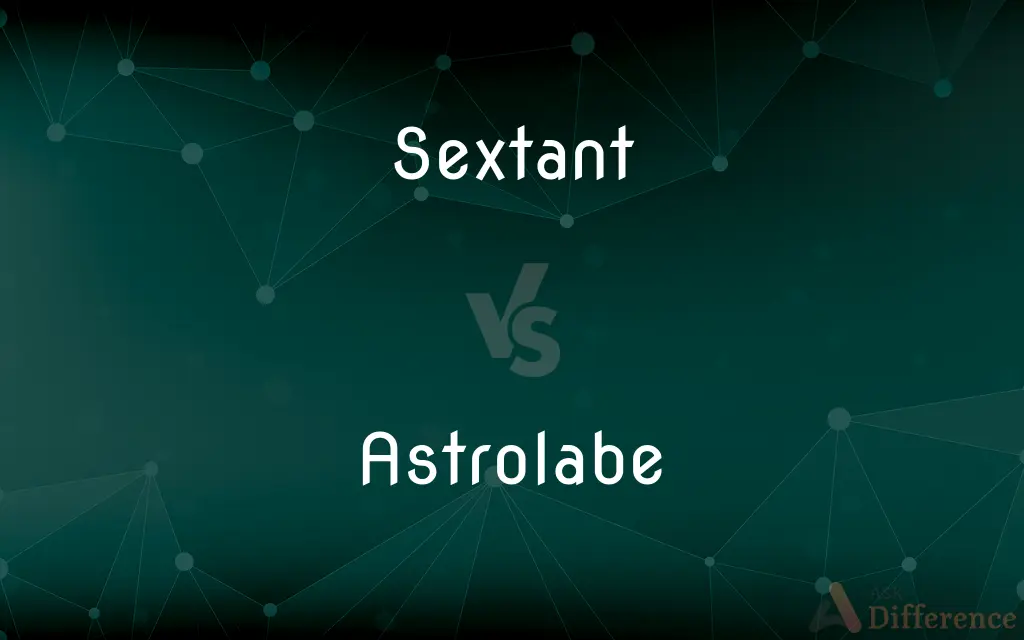Sextant vs. Astrolabe — What's the Difference?
Edited by Tayyaba Rehman — By Fiza Rafique — Updated on November 6, 2023
A sextant is a navigational tool used to measure the angle between two visible objects, mainly in maritime navigation. An astrolabe is an ancient astronomical instrument used for solving problems related to time and the position of the stars.

Difference Between Sextant and Astrolabe
Table of Contents
ADVERTISEMENT
Key Differences
A sextant is a navigational device used at sea to measure the angle between celestial objects and the horizon, essential for determining latitude and longitude. An astrolabe, by contrast, is an older astronomical tool used to make various celestial measurements, often utilized by astronomers and navigators to determine the position of the sun, stars, and planets.
The sextant, characterized by its arc shape which represents one-sixth of a circle, is a precision instrument that employs mirrors to bring into line the image of a celestial body with the horizon. The astrolabe consists of a flat disc with movable parts and is primarily used to show how the sky looks at a specific place at a given time, serving as a mechanical representation of the celestial sphere.
While the sextant is specifically designed for use at sea and improved upon the older astrolabe's capabilities, allowing for more accurate navigation, the astrolabe was historically used for a broader range of purposes. It helped to determine the time during the day or night and could be employed in surveying and astrology.
Technological advances have largely replaced the sextant in modern navigation with electronic tools such as GPS, but it remains a valuable skill and backup tool for sailors. The astrolabe, no longer in common use today, provided a fundamental step in the development of astronomical understanding and was critical in the age before the telescope.
The sextant and the astrolabe reflect the evolving technologies of their times. The sextant's use in the age of sail allowed for exploration and the mapping of the world's oceans, while the astrolabe's legacy lies in its contribution to early astronomy and navigation, representing a bridge between the ancient and medieval worlds.
ADVERTISEMENT
Comparison Chart
Primary Use
Measuring angles for navigation.
Determining celestial positions.
Historical Period
18th century to present.
Ancient times to the late Renaissance.
Complexity
Precision instrument with mirrors.
Intricate, with overlapping plates.
Measurement
Accurate angular measurements.
Approximate celestial measurements.
Portability
Hand-held and portable at sea.
Typically larger and less portable.
Compare with Definitions
Sextant
A tool for measuring the angular distance between two objects.
(The navigator used a sextant to find our position at sea.)
Astrolabe
An ancient instrument for solving problems related to time and the stars.
(The astrolabe was used to predict star positions.)
Sextant
A device with a graduated arc of 60 degrees used in celestial navigation.
(With his sextant, he measured the altitude of the sun at noon.)
Astrolabe
A tool for finding the positions of the sun, moon, and stars.
(Navigators once relied on the astrolabe to chart their course.)
Sextant
A navigational aid that uses mirrors to sight objects.
(He adjusted the sextant's mirrors to bring the horizon and star into alignment.)
Astrolabe
A historical astronomical device used to observe planetary movements.
(Astrolabes were the GPS of their time, guiding explorers across unknown lands.)
Sextant
A maritime tool for measuring angles between the horizon and a celestial body.
(Training in using the sextant is vital for sailors.)
Astrolabe
An instrument used by astronomers before the invention of the telescope.
(The astrolabe is a remarkable testament to the ingenuity of early scientists.)
Sextant
An instrument for determining latitude and longitude at sea.
(The sextant is essential for ocean voyages where landmarks are absent.)
Astrolabe
An early device for measuring the altitude of celestial bodies.
(By the astrolabe, they determined the height of the stars above the horizon.)
Sextant
A sextant is a doubly reflecting navigation instrument that measures the angular distance between two visible objects. The primary use of a sextant is to measure the angle between an astronomical object and the horizon for the purposes of celestial navigation.
Astrolabe
An astrolabe (Ancient Greek: ἀστρολάβος astrolabos; Arabic: ٱلأَسْطُرلاب al-Asturlāb; Persian: ستارهیاب Setāreyāb) is an ancient astronomical instrument that was a handheld model of the universe. Its various functions also make it an elaborate inclinometer and an analogue calculation device capable of working out several kinds of problems in astronomy.
Sextant
An instrument with a graduated arc of 60° and a sighting mechanism, used for measuring the angular distances between objects and especially for taking altitudes in navigation and surveying.
Astrolabe
A medieval instrument, now replaced by the sextant, that was once used to determine the altitude of the sun or other celestial bodies.
Sextant
A navigational instrument containing a graduated 60-degree arc, used for measuring the altitudes of celestial bodies for use in determining the latitude and longitude of the observer.
Astrolabe
An astronomical and navigational instrument for gauging the altitude of the Sun and stars.
Sextant
Sextant See Sextans.
Astrolabe
An instrument for observing or showing the positions of the stars. It is now disused.
Sextant
(nautical) A navigational device for deriving angular distances between objects so as to determine latitude and longitude.
Astrolabe
A stereographic projection of the sphere on the plane of a great circle, as the equator, or a meridian; a planisphere.
Sextant
(geometry) One sixth of a circle or disc; a sector with an angle of 60°.
Astrolabe
An early form of sextant
Sextant
(dentistry) One of six groups of adjacent teeth, excluding the wisdom teeth. The front sextants go from canine to canine, and there are sextants on the right and left of these. See w:Periodontal examination.
Sextant
The sixth part of a circle.
Sextant
An instrument for measuring angular distances between objects, - used esp. at sea, for ascertaining the latitude and longitude. It is constructed on the same optical principle as Hadley's quadrant, but usually of metal, with a nicer graduation, telescopic sight, and its arc the sixth, and sometimes the third, part of a circle. See Quadrant.
Sextant
The constellation Sextans.
Sextant
A unit of angular distance equal to 60 degrees
Sextant
A measuring instrument for measuring the angular distance between celestial objects; resembles an octant
Common Curiosities
Can an astrolabe be used for navigation?
Yes, historically, astrolabes were used for basic navigation before being replaced by more precise instruments like the sextant.
Are astrolabes still produced today?
Astrolabes are mainly produced as historical replicas or educational tools, not for practical navigation.
What's the main advantage of a sextant over an astrolabe?
A sextant offers more precise measurements and is easier to use on the unstable deck of a ship.
Is the sextant still used today?
While less common due to GPS, the sextant is still used as a reliable backup for navigation at sea.
How accurate is a sextant?
A sextant can be extremely accurate, with errors as small as a few arc seconds.
What is a modern equivalent of the astrolabe?
Modern equivalents to the astrolabe include digital planetariums and astronomy software.
Is it difficult to learn to use an astrolabe?
The use of an astrolabe can be complex and typically requires an understanding of astronomy and geometry.
What is a sextant used for?
A sextant is used for measuring the angle between celestial objects and the horizon for navigation.
What were astrolabes made of?
Astrolabes were typically made from brass or other durable metals to ensure precise measurements.
Did the sextant improve global navigation?
Yes, the sextant was crucial in the age of exploration, allowing for improved mapping and ocean navigation.
What's the key component of a sextant?
The key components of a sextant are its mirrors and graduated arc for measuring angles.
Are there different types of sextants?
Yes, there are various types of sextants, including bubble sextants used in aviation.
How does a sextant measure distance?
A sextant doesn't measure distance directly; it measures angles which can be used to calculate distance when the observer's altitude is known.
Can an astrolabe determine latitude?
Yes, an astrolabe can be used to determine latitude by measuring the angle of a celestial body above the horizon.
What is the history of the astrolabe?
The astrolabe has a rich history, dating back to ancient Greece and used through the Middle Ages.
Share Your Discovery

Previous Comparison
Bail vs. Bale
Next Comparison
Slag vs. FluxAuthor Spotlight
Written by
Fiza RafiqueFiza Rafique is a skilled content writer at AskDifference.com, where she meticulously refines and enhances written pieces. Drawing from her vast editorial expertise, Fiza ensures clarity, accuracy, and precision in every article. Passionate about language, she continually seeks to elevate the quality of content for readers worldwide.
Edited by
Tayyaba RehmanTayyaba Rehman is a distinguished writer, currently serving as a primary contributor to askdifference.com. As a researcher in semantics and etymology, Tayyaba's passion for the complexity of languages and their distinctions has found a perfect home on the platform. Tayyaba delves into the intricacies of language, distinguishing between commonly confused words and phrases, thereby providing clarity for readers worldwide.














































